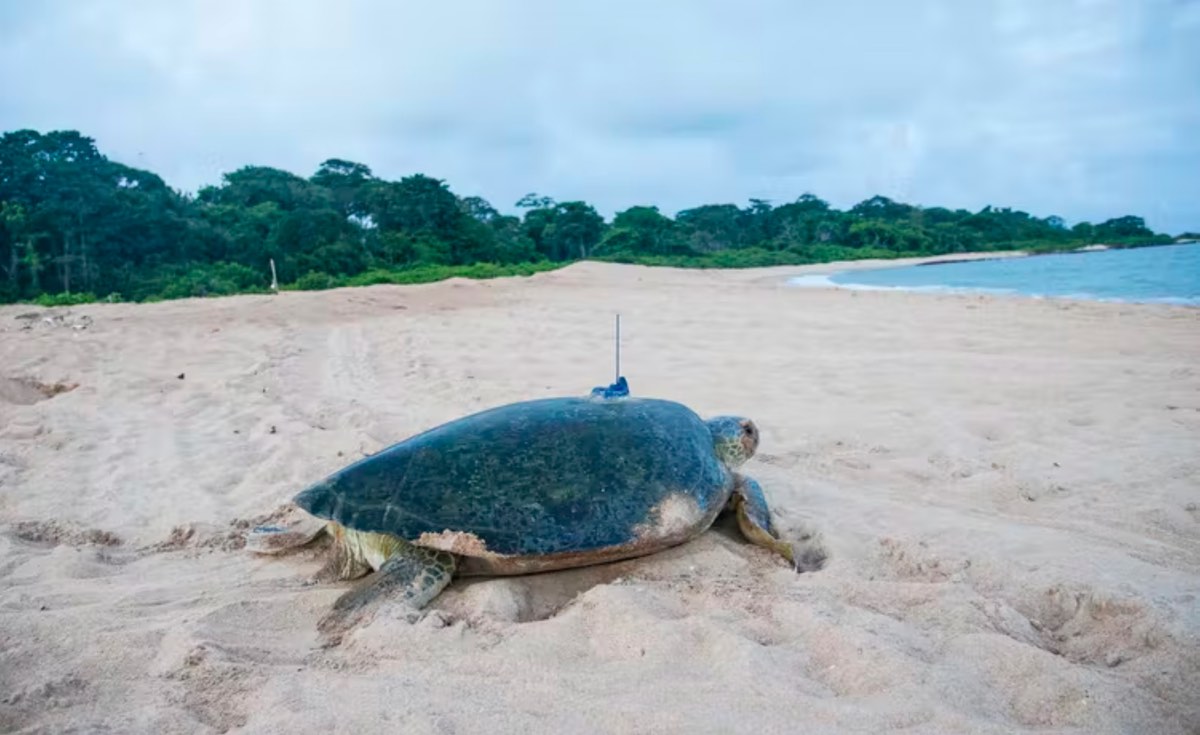By Ana Rita Patricio, University of Exeter and Martin Beal, ISPA
Sea turtles have been swimming the world’s oceans and nesting on its beaches for over 120 million years. They even survived mass extinction events, including the one that saw the end of the large dinosaurs.
Throughout human history sea turtles have played key roles in the culture and diet of coastal populations around the world. But in modern times, over-exploitation of sea turtle meat, eggs, cartilage, oil, and body parts, caused population declines and even local extinctions. They also face threats from plastic ingestion and climate change.
Among the seven species of sea turtles, the green turtle was historically the most exploited for human consumption. Green turtles are a key element of West Africa’s biodiversity heritage and contribute to the health of coastal marine ecosystems in the region. But protecting them is difficult, in part because they perform some of the longest migrations known in the animal kingdom.
These grand movements pose a major conservation challenge: how do we protect animals that cross international borders and can therefore experience varying levels of protection and human-caused threats?
We conducted research around the small island of Poilão off the coast of Guinea-Bissau. The island is part of the Bijagós archipelago which hosts one of the largest green turtle populations in the world. The core nesting site for this population is Poilão island where around 25,000 turtles make their nests annually.
In our recent study, we glued tracking devices to the shells of green turtles to study their movements. These devices transmitted their locations to orbiting satellites, allowing us to know where they are in near real-time.
We used the turtles’ positions to map the marine areas they occupy and estimate how much time they spent within marine protected areas.
We found that the green turtles from Poilão connect at least five West African nations. Some turtles remained year-round in the waters of Guinea-Bissau or nearby in Guinea, to the south. Others travelled some 400 km north to feed in Senegal and The Gambia, or even as far as 1000 km northwards to the Bay of Arguin, in Mauritania.
We concluded from our findings that meeting the challenge of protecting the sea turtles calls for international cooperation for conservation coupled with an understanding of the geographic connectivity that they create.
The life-cycle of green turtles
When newly hatched green turtles emerge from the nest, they quickly crawl to the sea and soon disappear from sight.
They spend the first three to five years in the vast open ocean, after which they approach the coast to settle in areas rich in food.
For a green turtle, beds of seagrass and macroalgae are the typical habitats they seek for nourishment.
Female green turtles only reach adulthood at about 20 years old, at which point they return to lay their eggs on the same sandy beach where they emerged as hatchlings all those years ago.
After breeding, they return to their feeding grounds and take a much needed break from travelling, mating, making and laying eggs, which usually lasts about three years.
The beach at Poilão is patrolled by conservation teams during the peak of the nesting season (August to November), granting protection to the turtles that come ashore to nest. But turtles don’t stay long on the beach. Within two hours they have laid their eggs and returned to the sea.
Throughout the course of a breeding season, females lay between three and six clutches of eggs, at 12-day intervals, after which they migrate to their feeding grounds.
As green turtles are known to migrate sometimes thousands of kilometres between nesting and feeding areas, knowing their whereabouts is essential to assessing what threats they may face along the way. For example, if turtles were heavily captured for their meat at faraway feeding areas, the efforts in place on the nesting beaches of Poilão would be fruitless.
Studying the movements of turtles from the Bijagós Archipelago was therefore necessary to understand what level of protection the population has while at sea.
Revelations from satellite tracking
The research was conducted in partnership with biodiversity managers from Guinea-Bissau, Senegal and Mauritania, and provides a scientific basis for decision-making on effective conservation measures.
Based on the movements of the turtles, we were able to provide recommendations for conservation managers on how they could improve protection of important sites.
For example, we show for the first time that most of the coastal waters of the Bolama-Bijagós Biosphere Reserve in Guinea-Bissau are used as feeding grounds by this population. This is a strong argument for implementing fishing regulations in this reserve to reduce the risk of turtles being captured in fishing gear.
Our findings also show that the Regional Network of Marine Protected Areas of West Africa encompasses most of the habitats used by this important population. Turtles spent over 90% of their time inside the boundaries of the area during breeding, and 78% of their time when foraging.
However, we also identified locations, particularly during migration, where protection could be improved.
Our findings also have relevance for local communities in the region. For the Bijagós people it is a matter of pride that green turtles travel from so many different places to nest on their pristine beaches. Likewise, the Imraguen people, the sole residents of the Banc d’Arguin National Park, take pride in maintaining productive waters with vast seagrass beds, where green turtles can flourish.
Additionally, healthy sea turtle populations can promote eco-tourism through turtle watching activities, suggesting that the successful conservation of this globally important population may be economically beneficial to people across the region.
Ana Rita Patricio, Postdoctoral research fellow, University of Exeter and Martin Beal, Research Assistant, ISPA
This article is republished from The Conversation under a Creative Commons license. Read the original article.

